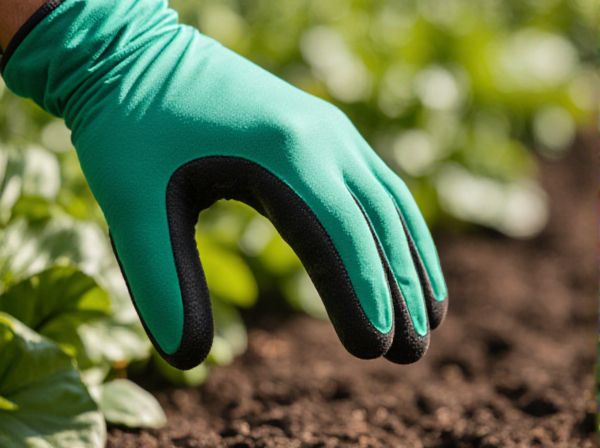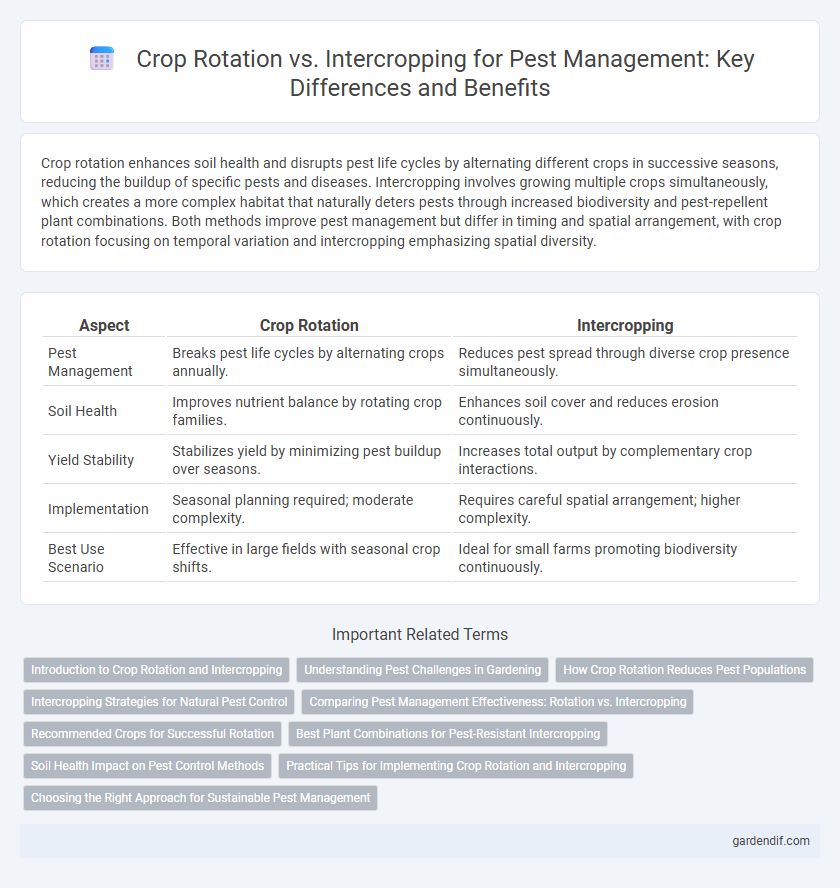
Crop rotation vs intercropping Illustration
Crop rotation enhances soil health and disrupts pest life cycles by alternating different crops in successive seasons, reducing the buildup of specific pests and diseases. Intercropping involves growing multiple crops simultaneously, which creates a more complex habitat that naturally deters pests through increased biodiversity and pest-repellent plant combinations. Both methods improve pest management but differ in timing and spatial arrangement, with crop rotation focusing on temporal variation and intercropping emphasizing spatial diversity.
Table of Comparison
| Aspect | Crop Rotation | Intercropping |
|---|---|---|
| Pest Management | Breaks pest life cycles by alternating crops annually. | Reduces pest spread through diverse crop presence simultaneously. |
| Soil Health | Improves nutrient balance by rotating crop families. | Enhances soil cover and reduces erosion continuously. |
| Yield Stability | Stabilizes yield by minimizing pest buildup over seasons. | Increases total output by complementary crop interactions. |
| Implementation | Seasonal planning required; moderate complexity. | Requires careful spatial arrangement; higher complexity. |
| Best Use Scenario | Effective in large fields with seasonal crop shifts. | Ideal for small farms promoting biodiversity continuously. |
Introduction to Crop Rotation and Intercropping
Crop rotation involves systematically changing the types of crops grown on a specific field across different seasons to disrupt pest life cycles and reduce soil depletion. Intercropping is the practice of growing two or more crops simultaneously on the same land to enhance biodiversity and minimize pest outbreaks. Both strategies promote sustainable pest management by leveraging crop diversity and ecological balance.
Understanding Pest Challenges in Gardening
Crop rotation reduces pest pressure by interrupting the life cycles of soil-borne pathogens and insect pests, leading to decreased populations of specific pests associated with certain crops. Intercropping creates a diverse plant environment that confuses pests and reduces the likelihood of severe infestations by attracting beneficial predators and disrupting pest host-finding. Both practices enhance biological pest control, improve soil health, and contribute to sustainable pest management in gardening.
How Crop Rotation Reduces Pest Populations
Crop rotation disrupts pest life cycles by alternating crop species, which prevents pests from establishing stable populations on a single host plant. This practice reduces specific pest build-up as many pests specialize in particular crops, lowering overall infestation rates and damage. Incorporating diverse crops through rotation enhances soil health and natural predator habitats, indirectly suppressing pest populations.
Intercropping Strategies for Natural Pest Control
Intercropping strategies enhance natural pest control by diversifying plant species, which disrupts pest habitat and reduces their spread. Combining crops with repellent or trap plants helps attract beneficial insects and predators that naturally suppress pest populations. This sustainable practice minimizes reliance on chemical pesticides while promoting ecosystem balance and crop health.
Comparing Pest Management Effectiveness: Rotation vs. Intercropping
Crop rotation effectively disrupts pest life cycles by alternating host crops, reducing pest population buildup seasonally. Intercropping enhances pest management through increased biodiversity, which attracts natural predators and confuses pests, lowering infestation levels. Studies show intercropping often provides more consistent suppression of pests across growing seasons compared to crop rotation alone.
Recommended Crops for Successful Rotation
Legumes such as soybeans, peas, and clover are highly recommended for crop rotation due to their nitrogen-fixing abilities that enhance soil fertility and reduce pest populations. Combining cereals like corn or wheat with crops like alfalfa or mustard helps disrupt pest life cycles and minimizes disease buildup. Incorporating diverse families such as nightshades, brassicas, and cucurbits in rotation schedules provides effective pest management and boosts overall crop health.
Best Plant Combinations for Pest-Resistant Intercropping
Selecting optimal plant combinations such as corn with beans or tomatoes with basil enhances pest resistance by disrupting pest life cycles and repelling harmful insects through complementary growth patterns. Incorporating marigolds alongside crops like cucumbers or peppers naturally deters nematodes and aphids, reducing reliance on chemical pesticides in intercropping systems. Crop rotation combined with pest-resistant intercropping strategies significantly lowers pest populations and improves overall soil health, promoting sustainable agricultural productivity.
Soil Health Impact on Pest Control Methods
Crop rotation disrupts pest life cycles by alternating plant families, reducing pest populations and disease incidence in the soil, while intercropping enhances biodiversity and promotes natural pest predators. Maintaining diverse root systems with crop rotation improves soil structure and microbial activity, essential for suppressing soil-borne pathogens. Intercropping supports balanced nutrient cycling and pest resistance, leading to healthier plants and reduced reliance on chemical controls.
Practical Tips for Implementing Crop Rotation and Intercropping
Implement crop rotation by alternating pest-susceptible crops with pest-resistant varieties to disrupt pest life cycles and reduce infestations naturally. Intercropping with companion plants such as marigolds or basil enhances pest deterrence while improving soil health and biodiversity. Use precise planting schedules and monitor pest populations regularly to optimize the benefits of both methods in integrated pest management systems.
Choosing the Right Approach for Sustainable Pest Management
Crop rotation disrupts pest life cycles by alternating plant families, reducing pest populations and soil-borne diseases, while intercropping enhances biodiversity, creating a habitat for natural predators and reducing pest infestations. Selecting the appropriate method depends on crop type, pest species, and local environmental conditions to maximize pest suppression and maintain soil health. Integrating both strategies can optimize pest management, promoting sustainable agriculture and minimizing chemical pesticide reliance.
Crop rotation vs intercropping Infographic

 gardendif.com
gardendif.com